The Bradford Odeon was the third biggest cinema in the country when it was built in 1930. Crudely subdivided into a multiscreen in the 1960s, then abandoned in 2000, local people have successfully turned this special but derelict building into a regional live entertainment venue, reports Thomas Lane.

Last Friday, the first event for 25 years took place in Bradford’s former Odeon cinema. Now called Bradford Live in recognition that the venue will host live events rather than films, it can accommodate 3,800 people in a vast auditorium that will fill the gap for a medium-sized live music and events venue located between Leeds and Manchester.
Derelict since 2000 when the Odeon closed, it was purpose built in 1930 as the New Victoria during the golden age of cinema and was the third largest in Britain at the time and the first to be purpose-built for “talkies”. It could also host theatre on a large stage.
The building was a lavish affair with two distinctive turrets at each end of the curved front elevation with elaborate decorative plasterwork adorning the auditorium and other areas including a grand ballroom and 200-seat restaurant. In the 1950s and 60s the building hosted stars including Buddy Holly, the Rolling Stones and the Beatles.
But as television displaced the cinema, he enormous auditorium became difficult to fill. So, in 1968, it was split into two smaller screens with a bingo hall underneath. In 2000 a new multiscreen Odeon opened on the eastern edge of Bradford, sealing the building’s fate.
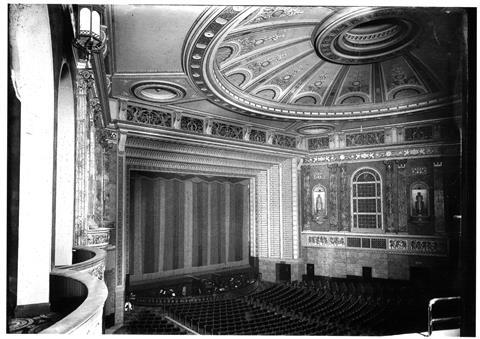
What makes this story remarkable is how the building has been saved and reinvented for the 21st century by the dogged determination of local people against all the odds, including costs which spiraled from £23m to £50m.
After the Odeon closed in 2000, plans were drawn up to demolish the building and redevelop it as a hotel, offices and apartments. This generated stiff local opposition culminating in 1,000 people taking part in the July 2007 “hug the Odeon” protest event.
The redevelopment plans were killed off by the 2009 financial crash, with Bradford council buying the building back from redevelopment agency Yorkshire Forward for £1. Local Lee Craven enlisted the help of two schoolfriends Kirsten Branston and Chris Morrell to work up a bid to refurbish the building as a live music and events venue for a council-run competition.
Up against a competing bid with similar plans, the trio won on the grounds that a private operator – NEC – would run the venue and pay back the loans needed to finance the refurbishment. None of the three had any experience of running a large live events venue or large building refurbishments, yet they tackled everything that needed doing.
“We did whatever needed to be done, from concept to funding to legal to construction, operator to social media, PR, legal, finance, recruiting and managing all the design team,” explains Branston, a former bank manager and director of Bradford Live.
It was excitingly derelict when we first got in there and quite an adventurous process to find your way around it
Andrew Toohey, partner, Price & Myers
To help work up the bid, Craven had engaged theatre consultant Carr & Angier to advise on possible uses for the building. They introduced him to Tim Ronalds Architects, with whom they had previously worked on the Hackney Empire refurbishment. Structural engineer Price & Myers had a long-standing relationship with Tim Ronalds Architects and was asked to go and assess the building to get an idea of what the refurbishment would involve.
“It was excitingly derelict when we first got in there and quite an adventurous process to find your way around,” says Andrew Toohey, partner at Price & Myers, describing how he negotiated his way through the building with a torch. Water was getting in everywhere, with plaster falling off the laths and mushrooms thriving in the damp atmosphere, he says.

Toohey surveyed what was accessible including the auditorium roof, which is supported by huge, 43m-long rivetted plate trusses. Accessing all the spaces was not possible, particularly the parts of the auditorium hidden by the 1960s conversion. The council eventually paid for a 3D point cloud survey.
“That was a real lifesaver as this could go into these really dark spaces and still be able to scan the whole volume and, by assembling those volumes in the right place and space, you could work out what you had not seen yet and where you needed to get into inaccessible voids, and scan that as well so the pieces of the puzzle came together,” Toohey says. Asbestos was a problem as, each time it was removed, new surveys found more.
When the conversion was done, they smashed it up and took everything out. That’s how they did it in the 1960s – they didn’t want all this old stuff, they wanted an exciting new future for the country
Adam Goodfellow, partner, Tim Ronalds Architects
When work started, Price & Myers had to carefully survey the 1960s conversion to ensure it was not supporting any of the existing structure before the conversion was demolished. “It was a case of understanding what it held up, whether in installing it they had cut away any original primary structure or whether it was just additive. It was quite a job to piece that together,” Toohey explains.
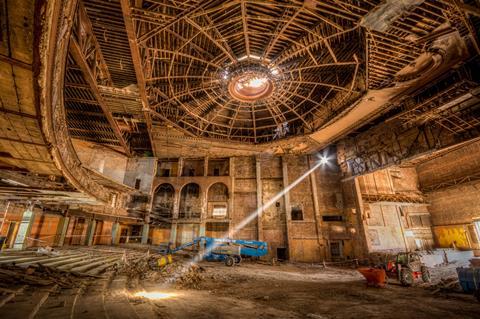
Investigations revealed that the 1960s insertion could be safely removed and the auditorium fully revealed for the first time in 50 years. Sadly, the opulence of the original was largely gone.
“When the conversion was done, they smashed it up and took everything out,” explains Adam Goodfellow, partner at Tim Ronalds Architects. “That’s how they did it in the 1960s. They didn’t want all this old stuff, they wanted an exciting new future for the country.”
Damage included a large chunk cut out of the balcony to divide the space up and the ceiling plaster had been removed. On top of this water had got in and rotted the hessian supporting the plaster so it could not be salvaged. The stage floor was completely rotten, and the lightweight precast plank floor of the auditorium was mostly beyond rescue as the planks featured a timber core which had also rotted away. Water damage was widespread throughout the building including in the two turrets and the restaurant.
Remarkably, the ballroom had escaped the worst ravages of time despite being converted into a third screen in 1988, by which time thankfully attitudes to historic buildings had changed. “In the 1980s they didn’t smash everything up, they put a new raked floor and seating in and a new ceiling under the original ceiling – which, thankfully, survived,” says Goodfellow.
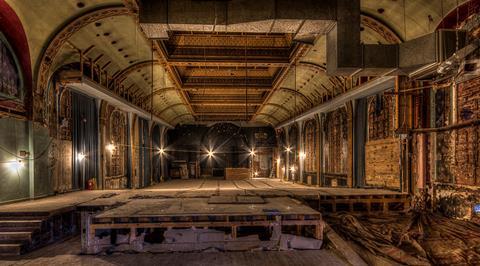
What was to be done with the building given that so much of the original fabric had gone? According to Goodfellow, long experience of refurbishing old entertainment venues had taught the practice to do no more than necessary.
“We have found that, no matter what you do to an old building – whether you restore it or put in modern insertions – that historic character and atmosphere is often lost in the process. The less you do, the better; and the more atmosphere you keep, the more attractive, exciting and atmospheric the building is at the end of it. So we try not to do too much.”
This is easier said than done, Goodfellow says, as fitting services and new structure into old buildings to meet modern requirements without these impinging on the aesthetic is difficult. “It’s almost like doing surgery, very fine work trying to thread things in, eking out space for services in buildings that were built when people didn’t really bother with services – they just opened a window or lit a fire.”

As so much of the plaster in the auditorium had gone, the decision was made to leave the brickwork, which was exposed and in decent condition. The elaborate plasterwork of the classical, stepped proscenium arch of the stage was replicated with a simple framing of four red, painted steel arches. The auditorium roof steelwork and joists have been left exposed with the roof built up above to meet modern thermal and acoustic standards.
Toohey says this required complex calculations as the capacity of built-up rivetted steel structures is notoriously hard to understand. “We’ve added quite a lot of material onto the roof to get it functioning well enough acoustically and thermally so quite a lot of extra weight has been added. So we had to back-calculate through everything, literally through every rivet.”
There was very little spare capacity in the buildings’ structure, he adds, so finding a suitable replacement for the lightweight precast planks used for the floor was a challenge. A lightweight concrete over steel decking was adopted as the solution. The missing section of balcony was reinstated and it was strengthened to meet modern vibration standards.
The iron beams over a culvert under the rear part of the building were found to be collapsing, adding to the costs.
What is the building like?
Walking into the auditorium is a shock because, knowing it was built as a cinema, you expect it to be cinema sized. Instead, it is vast with a capacity of 3,800 people matching other regional venues including the recently opened, purpose built £46m Vaillant Live in Derby and the O2 Victoria Warehouse in Manchester.
Bradford Live is double the capacity of Bristol Beacon, another council-backed refurbishment project which went wildly over budget, costing £123m rather than the original £48.8m. This makes the £50m cost of Bradford Live seem good value.
The auditorium has plenty of room for stall seating as it is more than 50m long from the front of the stage to the rear of the balconies. There are two balconies, and the stall seats are removable for standing events and will be stored in the new extension behind the stage.
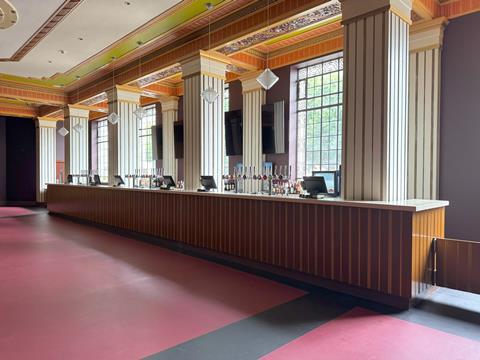
Virtually none of the opulent, original interior remains apart from the elaborate decoration on the balcony fronts – only one half of this remains on the lower balcony thanks to the rest being hacked out during the unsympathetic 1960s alterations. The sides of the auditorium are bare brick, the arches over the boxes at the sides are retained and the roof structure is clearly visible including the steelwork of the original 21m diameter central dome and the joists of the roof above.
The dome steelwork is a strong architectural feature, still performing its original role as a centrepiece to this vast space. The auditorium is austere and functional, with only the balconies providing a hint of its former glory and the patina of the brickwork suggesting the building’s history.
The ballroom is a stark contrast to the auditorium, having been restored to its former decorative plastered state. It features gilded pilasters, arched mirrors and walls which curve around to meet a sequence of elaborately detailed roof lights which these days provide controllable artificial light rather than daylight. The space can be configured for smaller live events.
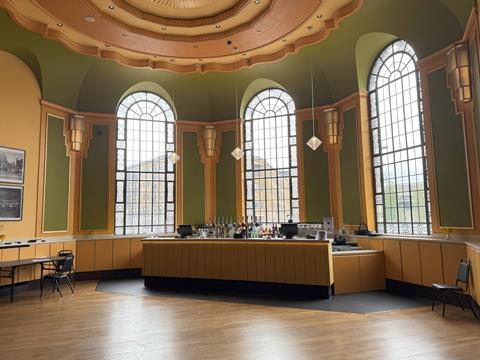
When it comes to food and drink, there is plenty on offer. There are two bars directly behind the auditorium following the curve of the back wall. These serve the stalls and circle and both echo the bare brick aesthetic of the auditorium, with the fronts of the bars and sloping ceiling of the upper bar picked out in a vivid red that references the red, painted steel proscenium arch in the auditorium.
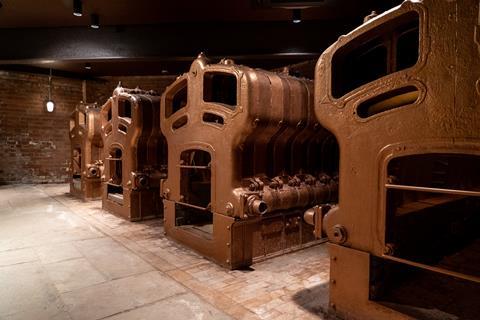
The former restaurant has also been carefully restored and will serve food and drink. This has been renamed the Gaumont Bar to recall the period when the building was called the Gaumont between 1950 and 1969. And there is the Boiler Room Bar in the basement, so called because the iron shells of the original coal-fired boilers have been kept as a historical link. This space will host more intimate music events.
There are another two bars, including one for VIPs, and further rooms housed in the two turrets. The broad range of facilities and performance spaces set a positive scene for the venue’s success with the architecture providing plenty of visual interest and strong connections to the building’s rich past.
Elsewhere some of the damaged plaster has been restored, notably in the restaurant and ballroom. Goodfellow explains why:
“Rather than just have a series of bald, empty brick spaces, we did put back the plaster and ceilings in some of the spaces. We couldn’t afford to do that throughout the building as the cost would have been unfathomable and it was never part of the plan, particularly in the auditorium.
“So you see the bones of the building where the bones look great. Other spaces look better with restored plaster, so you get a variety of spaces in the building now which adds to the excitement.”
Goodfellow concedes that the spaces with restored plaster have ended up looking new as it is very difficult to capture the atmosphere of the decayed original yet restore the damage.
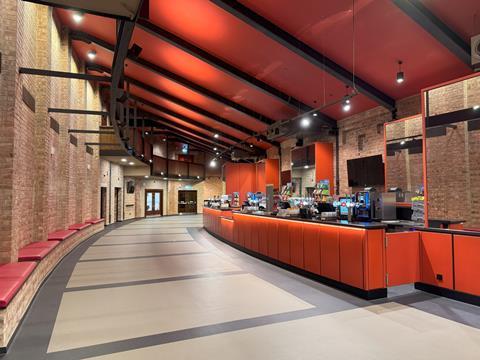
As he suggests, squeezing in modern services without these impinging aesthetically on the interior proved to be tricky. This was tackled by Buro Happold with the first job understanding how the building was originally serviced. Ventilation was provided by a network of underground ducts, which brought air from the outside into a plenum with a massive fan that blew air into the auditorium via ducts built into the brick walls.
“These days we can do complex CFD [computational fluid dynamics] analysis to work out exactly where the right place is to put air in and take it out of the auditorium is, and they got it pretty well right,” explains Christine Lowry, a partner and services engineer at Buro Happold. As a result, it made sense to reuse this ductwork.
“It was a well designed and ventilated space, which is why we were so keen to reuse what was there rather than just layer in a whole new modern system of ductwork.”
This was easier said than done because the auditorium originally had a capacity of 3,300 people but can now hold 3,800, which means more air was needed – plus air quality standards are higher than in the 1930s. Increasing the pressure to move more air through the ducts was not an option.
“We couldn’t accommodate much more uplift, because if you put too much more air through an existing duct, it just gets noisier and uses more energy,” explains Lowry. “To get the air volumes to a palatable flow rate meant we had to make all of the air that’s going in work for us.”
The CFD modelling was used to ensure that fresh, conditioned air was supplied where it was needed in the auditorium. The air diffusers were an important part of this strategy with some jetting air towards the centre of the auditorium and others supplying air more gently for people towards the sides.
The area above the audience is not conditioned, so the air is substantially warmer when it exits out of the top of the building. “We have really used those building ducts to replicate that original strategy because that gives us the experience of being in, and experiencing the space as it was,” says Lowry.
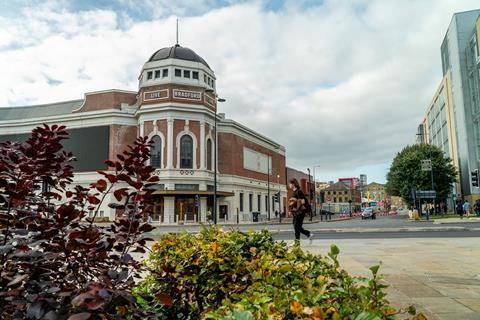
Finding the space for the bulky air-handling units was another challenge. Lowry says the volume of air needed has been minimised by building in capacity to only service the areas being used at any one time, rather than the whole building.
Four air-handling units were needed. One was put in the basement, another in the roof over a new extension behind the stage and the remaining two in a roof space between the auditorium and ballroom.
Practical completion was reached last year with fitout following on. The problems did not stop there, however, as last September NEC announced that it was pulling out of the deal. Although this was a blow, NEC’s involvement in getting the project off the ground had been essential thing, as no one would have backed the scheme without an operator on board.
Having put so much money into the scheme, Bradford council was now controlling the project and found a new operator, Trafalgar Entertainment, to take the venue on. This has a full programme of events following last Friday’s inaugural opening.
The increased costs of the project are a headache for the cash-strapped council, which was given the green light by the government to raise council tax by nearly 10%, the highest increase in the country. It can only be hoped that the residents of Bradford, who fought so successfully to keep the building, will think it was worth it.
Project team
Client: Bradford Council / Bradford Live
Architect: Tim Ronalds Architects
Structural engineer: Price & Myers
MEP engineer: Buro Happold
QS/project manager: Turner & Townsend
Main contractor: RN Wooler
MEP specialist contractor: Pitts Wilson








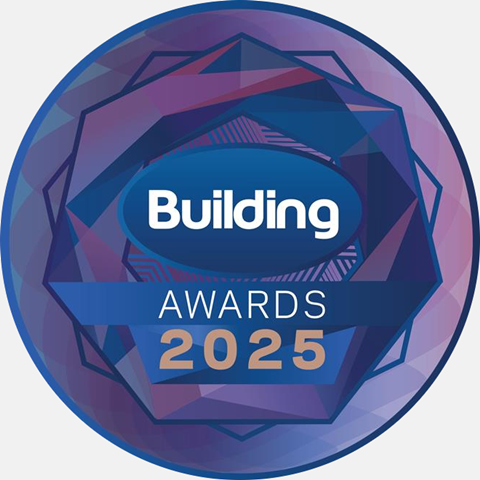








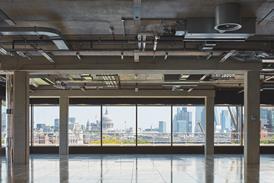
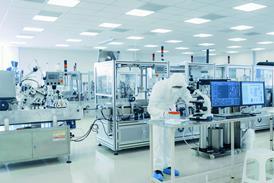








No comments yet